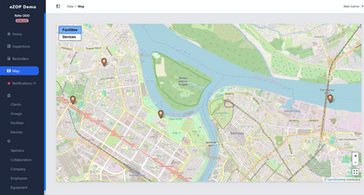Capability gaps addressed (IFAFRI reference):
#3 Rapid Identification,
#4 Integration of Information,
#5 Interoperable Communications, #9 Actionable Intelligence.
Technology Readiness Level: TRL 9 – the system has been proven in real‑world operations (12,000 bar‑coded devices across 20 organisations). What eZOP does: a cloud & mobile SaaS that digitises every fire‑safety asset with a unique QR/barcode, automates inspection schedules, integrates field data (photos, e‑signatures, IoT sensors) into a single dashboard, and pushes real‑time alerts to first‑responder chains. Innovation & differentiation:
100 % paperless “single‑pane” logbook compliant with national/EU regulations – first such system in South‑East Europe (market launch <3 yrs).
Offline‑first mobile app with < 1 s scan‑to‑record time; automatic sync to cloud once connectivity returns.
Open API + CSV/JSON export enables friction‑free data sharing with dedicated responsible organizations in the field of Fire Prevention departments.
Predictive analytics roadmap (Q4 2025) turns historical faults into risk heat maps and decision support for incident commanders. Compared with legacy Excel/paper or generic CMMS tools, eZOP provides an 80 % administration time saving and 70 % cost reduction per client, while giving first responders validated, up‑to‑date intelligence before arrival on the scene.

Contact

Objective: Close critical information and coordination gaps between facility owners and first‑responder units, making every fire‑safety asset in the Balkans digitally visible and inspection‑ready by 2028 and scaling EU‑wide by 2030.
Key milestones:
2025 – deploy 50,000 devices, launch IoT sensor module for hydrant pressure & extinguisher weight.
2026 – regional roll‑out (HR, BiH, SI, RO, MN, MK), multilingual UX, EN 54 export templates.
2027 – possibility of integration with national platforms for automated handover of site schematics & asset status or sectors for emergency situations.
2030 –> 3 million devices under management EU‑wide, AI risk engine live.
Relevance: Each year EU suffers € 35 bn fire losses and > 5,000 deaths; > 40 % of post‑incident reports cite maintenance or information failure. eZOP directly tackles this by ensuring assets are maintained, certified, and instantly identifiable, shortening information latency for first responders from hours to seconds.
Risk Mitigation – eZOP mitigates fire-risk by continuously tracking every extinguisher, hydrant and alarm in real time—status, expiry date, last inspection and on-site quantity. Automated alerts surface aging or missing equipment before it becomes critical, ensuring only certified, fully-functional assets stand between an outbreak and disaster.
Assessment Analysis – Assessment analysis benchmarks each registered site against our database: floor area, device density, reporting speed and labour hours saved versus legacy paper. Interactive dashboards let safety officers rate every location and asset, generating objective improvement scores that guide budget, staffing and compliance priorities.
Digital Twin of every fire asset – unique encrypted QR encodes ID + last service + spec; scan delivers full history even offline.
Edge‑to‑cloud architecture – microservice backend (Go & Postgres) auto‑scales; mobile client uses SQLite cache & conflict‑free replication for low‑connectivity zones.
Interoperability by design – REST/GraphQL API, Webhooks, EDXL‑CAP compliant export; ready for seamless plug‑in to PSAP/CAD platforms.
Human‑centred UX – co‑designed with certified fire inspectors; 55‑year‑old non‑tech end users pass onboarding in < 30 min.
Security & trust – ISO 27001 roadmap; end‑to‑end AES‑256 encryption, audit‑trail, and forthcoming qualified e‑signature for service reports (Q1 2026).
Environmental impact – saves > 2 tons of paper per year; cloud footprint offset via AWS Sustainability Pledge.
Legacy: inspectors rely on scattered paper logs → missed deadlines, outdated data, and slow incident handover.eZOP resolves by:
Planning – automated scheduler aligns national periodicities; alerts are sent 30/7/1 days ahead.
Execution – technicians scan QR, fill checklist, attach photos; record saved locally, then synced.
Consolidation – dashboard aggregates multi‑site compliance KPIs; red‑flag widgets guide corrective actions.
Sharing – one‑click export to PDF/JSON or secure link for the fire brigade/inspectorate.
Measured impact 2024 pilots: compliance on‑time rate up from 62 % → 99 %; inspection report prep‑time down from 90 min → 12 min; first‑responder pre‑arrival intelligence time down from > 1 h → instant.
Stefan Malinovic (Product designer & growth lead, 8 y UX/SaaS)
Marko Mihajlović (Sr. full‑stack & DevOps, 10 y, cloud security)
Hristina Milkić (Front‑end/mobile, React‑Native, bilingual EN/DE)
Marija Malbaša (PR & stakeholder outreach, 10 y B2B comms)
Luka Calic (Business Development Manager)
Marija Merdovic (Sales and B2B comms)
Marko Malbasa (CEO and General Director)
Igor Djuric (consultant from the National Association for Fire Prevention, Serbia)Stefan Malinovic (Product designer & growth lead, 8 y UX/SaaS)
Marko Mihajlović (Sr. full‑stack & DevOps, 10 y, cloud security)
Hristina Milkić (Front‑end/mobile, React‑Native, bilingual EN/DE)
Marija Malbaša (PR & stakeholder outreach, 10 y B2B comms)
Luka Calic (Business Development Manager)
Marija Merdovic (Sales and B2B comms)
Marko Malbasa (CEO and General Director)
Igor Djuric (consultant from the National Association for Fire Prevention, Serbia)


